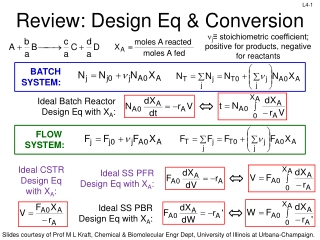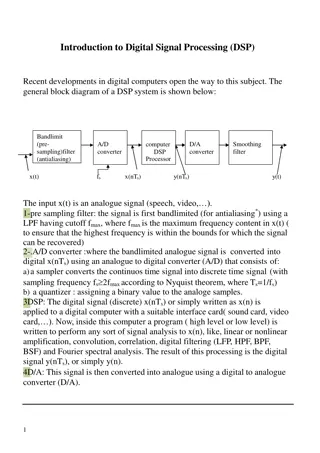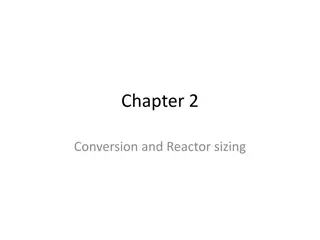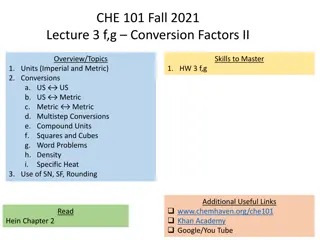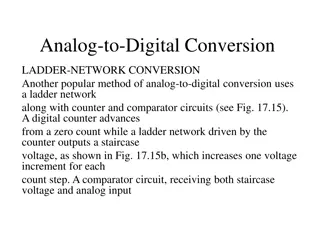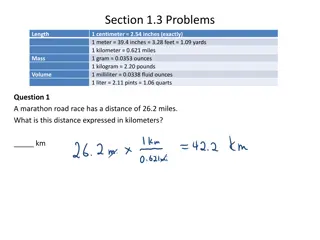
Unit Conversion and Cancellation in Physical Quantities
Explore the concept of unit conversion and unit cancellation in physical quantities through examples like converting grams to milliliters, feet to inches, meters to centimeters, and more. Understand how to apply conversion factors and equivalencies effectively for accurate measurements.
Download Presentation

Please find below an Image/Link to download the presentation.
The content on the website is provided AS IS for your information and personal use only. It may not be sold, licensed, or shared on other websites without obtaining consent from the author. If you encounter any issues during the download, it is possible that the publisher has removed the file from their server.
You are allowed to download the files provided on this website for personal or commercial use, subject to the condition that they are used lawfully. All files are the property of their respective owners.
The content on the website is provided AS IS for your information and personal use only. It may not be sold, licensed, or shared on other websites without obtaining consent from the author.
E N D
Presentation Transcript
Conversion Factors and Unit Cancellation
A physical quantity must include: Number 5 grams 12.5 mL + Unit of measure
Calculation Corner: Unit Conversion Equivalancies and conversion factors 1 foot = 12 inches equivalance
Calculation Corner: Unit Conversion 1 foot = 12 inches 1 foot = 1 12 inches Conversion factor
Calculation Corner: Unit Conversion 1 foot = 12 inches 1 foot = 1 12 inches 12 inches = 1 1 foot
Calculation Corner: Unit Conversion 1 foot 12 inches 12 inches 1 foot Conversion factors
Calculation Corner: Unit Conversion 1 foot 12 inches 12 inches 1 foot Conversion factors 3 feet is equal to how many inches? 12 inches ( ) 3 feet ( ) = 36 inches 1 foot
How many cm are in 1.32 meters? equality: 1 m = 100 cm (or 0.01 m = 1 cm) applicable conversion factors: ______ 1 m 100 cm ______ 1 m ) 100 cm or ( 1 m ______ 100 cm X cm = 1.32 m = 132 cm We use the idea of unit cancellation to decide upon which one of the two conversion factors we choose.
How many meters is 8.72 cm? equality: 1 m = 100 cm applicable conversion factors: ______ 1 m 100 cm ______ 1 m ) 100 cm or ( 1 m ______ 100 cm X m = 8.72 cm = 0.0872 m Again, the units must cancel.
How many feet is 39.37 inches? equality: 1 ft = 12 in applicable conversion factors: ______ 1 ft 12 in ______ 1 ft 12 in or ( ) ____ 1 ft 12 in X ft = 39.37 in = 3.28 ft Again, the units must cancel.
How many kilometers is 15,000 decimeters? ( 1 m( ) ) ____ 10 dm 1 km ______ X km = 15,000 dm = 1.5 km 1,000 m
How many seconds is 4.38 days? 24 h 1 d ( ) 60 min ( ) 1 min ( ) ____ _____ 60 s ____ X s = 4.38 d 1 h = 378,432 s If we are accounting for significant figures, we would change this to 3.78 x 105 s
Simple Math with Conversion Factors
Example Problem Measured dimensions of a rectangle: length (L) = 9.70 cm width (W) = 4.25 cm Find area of rectangle. L A = L . W = (9.70 cm)(4.25 cm) 2. cm = 41.2 cm W
Convert 41.2 cm2 to m2. ( ) ______ 1 m X m2 = 41.2 cm2 = 0.412 m2 WRONG! 100 cm = 0.412 cm.m Recall that 41.2 cm2 = 41.2 cm.cm ( 100 cm ) 100 cm ( ) ______ 1 m ______ X m2 = 41.2 cm.cm 1 m = 0.00412 m2 ( ) 2 ______ 100 cm 1 m X m2 = 41.2 cm2 = 0.00412 m2
Convert 41.2 cm2 to mm2. Recall that 41.2 cm2 = 41.2 cm.cm ( 10 mm ( ) ) 10 mm _____ _____ X mm2 = 41.2 cm.cm 1 cm 1 cm = 4,120 mm2 10 mm ( ) 2 _____ X mm2 = 41.2 cm2 = 4,120 mm2 1 cm
Measured dimensions of a rectangular solid: Length = 15.2 cm Width = 3.7 cm Height = 8.6 cm H W Find volume of solid. L V = L . W . H = (15.2 cm)(3.7 cm)(8.6 cm) 3 = 480 cm
Convert to m3. cm.cm.cm 100 cm ( ) 100 cm ( ) 100 cm ( ) 1 m _____ 1 m _____ 1 m _____ 3 2 X m3 = 480 cm = or 100 cm ( ( ) 3 1 m _____ X m3 = 480 cm3 = 0.000480 m3 or ) 3 _________ 1 m 4.80 x 10-4 m3 X m3 = 480 cm3 = 3 1000000 cm
Convert to m3... Measured dimensions of a rectangular solid: Length = 15.2 cm Width = 3.7 cm Height = 8.6 cm 0.152 m 0.037 m 0.086 m H W Find volume of solid. L V = L . W . H = (0.152 m)(0.037 m)(0.086 m) = 0.000480 m3
By what factor do mm and cm differ? 1 cm = 10 mm 10 By what factor do mm2 and cm2 differ? 100 (1 cm)2 = (10 mm)2 1 cm2 = 100 mm2 By what factor do mm3 and cm3 differ? (1 cm)3 = (10 mm)3 1 cm3 = 1000 mm3 1,000

